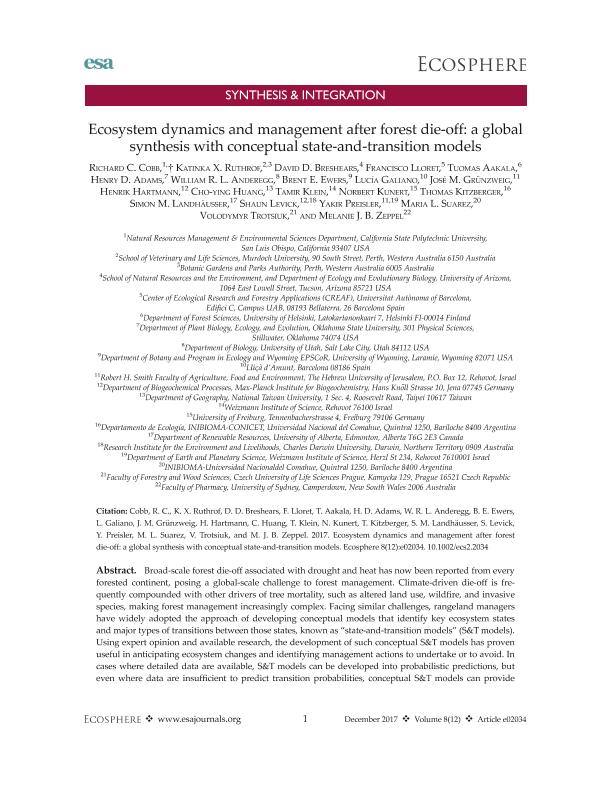Artículo
Ecosystem dynamics and management after forest Die-Off: A global synthesis with conceptual state-and-transition models
Cobb, Richard C.; Ruthrof, Katinka X.; Breshears, David D.; Lloret, Francisco; Aakala, Tuomas; Adams, Henry D.; Anderegg, William R. L.; Ewers, Brent E.; Galiano, Lucía; Grcunzweig, Jose M.; Hartmann, Henrik; Huang, Cho-ying; Klein, Tamir; Kunert, Norbert; Kitzberger, Thomas ; Landhäusser, Simon M.; Levick, Shaun; Preisler, Yakir; Suarez, Maria Laura
; Landhäusser, Simon M.; Levick, Shaun; Preisler, Yakir; Suarez, Maria Laura ; Trotsiuk, Volodymyr; Zeppel, Melanie J. B.
; Trotsiuk, Volodymyr; Zeppel, Melanie J. B.
 ; Landhäusser, Simon M.; Levick, Shaun; Preisler, Yakir; Suarez, Maria Laura
; Landhäusser, Simon M.; Levick, Shaun; Preisler, Yakir; Suarez, Maria Laura ; Trotsiuk, Volodymyr; Zeppel, Melanie J. B.
; Trotsiuk, Volodymyr; Zeppel, Melanie J. B.
Fecha de publicación:
12/2017
Editorial:
Ecological Society of America
Revista:
Ecosphere
ISSN:
2150-8925
e-ISSN:
2150-8925
Idioma:
Inglés
Tipo de recurso:
Artículo publicado
Clasificación temática:
Resumen
Broad-scale forest die-off associated with drought and heat has now been reported from every forested continent, posing a global-scale challenge to forest management. Climate-driven die-off is frequently compounded with other drivers of tree mortality, such as altered land use, wildfire, and invasive species, making forest management increasingly complex. Facing similar challenges, rangeland managers have widely adopted the approach of developing conceptual models that identify key ecosystem states and major types of transitions between those states, known as "state-and-transition models" (S&T models). Using expert opinion and available research, the development of such conceptual S&T models has proven useful in anticipating ecosystem changes and identifying management actions to undertake or to avoid. In cases where detailed data are available, S&T models can be developed into probabilistic predictions, but even where data are insufficient to predict transition probabilities, conceptual S&T models can provide valuable insights for managing a given ecosystem and for comparing and contrasting different ecosystem dynamics. We assembled a synthesis of 14 forest die-off case studies from around the globe, each with sufficient information to infer impacts on forest dynamics and to inform management options following a forest die-off event. For each, we developed a conceptual S&T model to identify alternative ecosystem states, pathways of ecosystem change, and points where management interventions have been, or may be, successful in arresting or reversing undesirable changes. We found that our diverse set of mortality case studies fit into three broad classes of ecosystem trajectories: (1) single-state transition shifts, (2) ecological cascading responses and feedbacks, and (3) complex dynamics where multiple interactions, mortality drivers, and impacts create a range of possible state transition responses. We integrate monitoring and management goals in a framework aimed to facilitate development of conceptual S&T models for other forest die-off events. Our results highlight that although forest die-off events across the globe encompass many different underlying drivers and pathways of ecosystem change, there are commonalities in opportunities for successful management intervention.
Archivos asociados
Licencia
Identificadores
Colecciones
Articulos(INIBIOMA)
Articulos de INST. DE INVEST.EN BIODIVERSIDAD Y MEDIOAMBIENTE
Articulos de INST. DE INVEST.EN BIODIVERSIDAD Y MEDIOAMBIENTE
Citación
Cobb, Richard C.; Ruthrof, Katinka X.; Breshears, David D.; Lloret, Francisco; Aakala, Tuomas; et al.; Ecosystem dynamics and management after forest Die-Off: A global synthesis with conceptual state-and-transition models; Ecological Society of America; Ecosphere; 8; 12; 12-2017; 1-17
Compartir
Altmétricas



